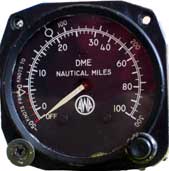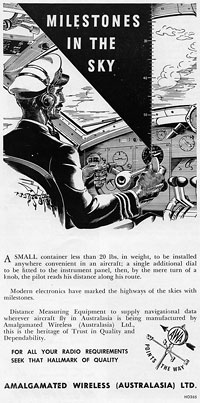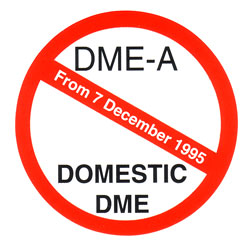The
Australian DME System
By
Roger Meyer

The Department has an enviable record of invention and innovation within its Airways Engineering and Airways Operations organisations. Most prominent, among many other smaller-scale innovations, are the Australian Distance Measuring Equipment (DME) system, the T-VASIS visual landing aid, and the Interscan landing system. All of these met, and exceeded, ICAO standards of performance, and were hailed for their engineering and operational achievement.
This article
describes the history of the Australian DME system, which gave over
forty years of valuable service to Australian civil aviation between
1955 and 1995. Indeed, Australia was the first country in the world
to have a civil DME system in service.
The first post-war conference aimed at regulating international air transport was the Chicago Convention, held in November 1944. It was here that the "Five Freedoms of the Air" were drafted, and are still the cornerstone of international air travel.
One of the many draft Annexes produced was Instrument Aids to Navigation, which include Annexe B, defining a radio beacon station as "a special station, the emissions of which are intended to enable an on-board station to determine its bearing or a direction with reference to the radio beacon station, and in some cases, also the distance which separates it from the latter". In other words, it confirmed the need for some form of distance measurement along an airway. Up to that time whilst continuous azimuth guidance on airways was provided by various types of radio beacons, progress along track could only be measured by station passage of a beacon - in other words, by flying over it.
Immediately after the Chicago Convention, a Commonwealth Air Transport Council was established to monitor and share views, information and developments of a civil aviation nature. An extension of this body, with responsibility for radio technical matters, was the Commonwealth and Empire Conference on Radio for Civil Aviation (CERCA). This body first met in Canada in November 1944, and produced specifications for suitable radio navigation aids, based on wartime inventions. In particular, it looked at developing a form of distance measurement, based on the Rebecca-Eureka ‘Identification Friend or Foe’ (IFF) secondary radar system, and operating in the 200 Mhz band.
The Provisional International Civil Aviation Organisation (PICAO) first met on 6 June 1945, charged with the task of development of the Chicago Convention draft annexes into a more permanent and workable form. The Air Navigation Committee formed a Special Radio Technical Committee (abbreviated COT). Its purpose was to standardise the technical characteristics of radio aids to navigation.
At the suggestion of the President of the PICAO Interim Council, the first meeting of COT was preceded by demonstrations of radio navigation aids and communications equipment to COT delegates by Canada, England and Australia.

The Australian demonstration was at Ottowa on 28 and 29 October 1946, and was of a DME system and a Multiple Track Radar Range, both being adaptations of the Second World War radar systems mentioned earlier, and both of which were based on the findings of the 1945 CERCA London meeting.
The Australian
demonstrations were conducted by the Division of Radiophysics of the
Council for Scientific and Industrial Research, CSIR, the predecessor
of today’s CSIRO.
The COT Division consisted of 140 delegates from 28 countries, and met
in Montreal from 30 October to 23 November, 1946. It considered the
relative merits of the 200 Mhz and 1,000 Mhz frequency bands for DME.
The great amount of operational experience which had been gained during
the war years with secondary radar systems operating in the 200 Mhz
band promised a technically successful operation of DME at that frequency.
However, this was countered by the USA proposal for a system operating
at 1,000 Mhz.
Above: This AWA advertisement from October 1953 in the Australian National Airways magazine Air Travel illustrated the significance of the safety and operational benefits brought by DME. Click on the ad to see a larger version.
The Australian Domestic DME network eventually encompassed at least 84 beacons. These included en route beacons on major air routes such as at Dederang in NSW, beacons at major airports, and beacons at many regional airports such as Wittenoom Gorge in WA and Roma in Qld. Click here to see a 1955 airways chart showing early DME sites.

From the 1960s the Australian system was known as DME(A) to distinguish it from the 'international', or DME(I), 1000 MHz system. The system continued in operation until 7 December 1995 when all the DME(A) beacons were withdrawn. Only a much smaller number of DME(I) beacons remain in service. The sticker at left was produced and distributed to industry in late 1995 as a reminder of the forthcoming closure of the network.
Click here to see photos of the Australian DME installation.
Click here to read the Operational Notes on DME
Back to the main Communications and Navigation Index
If this page
appears without a menu bar at top and left, click
here